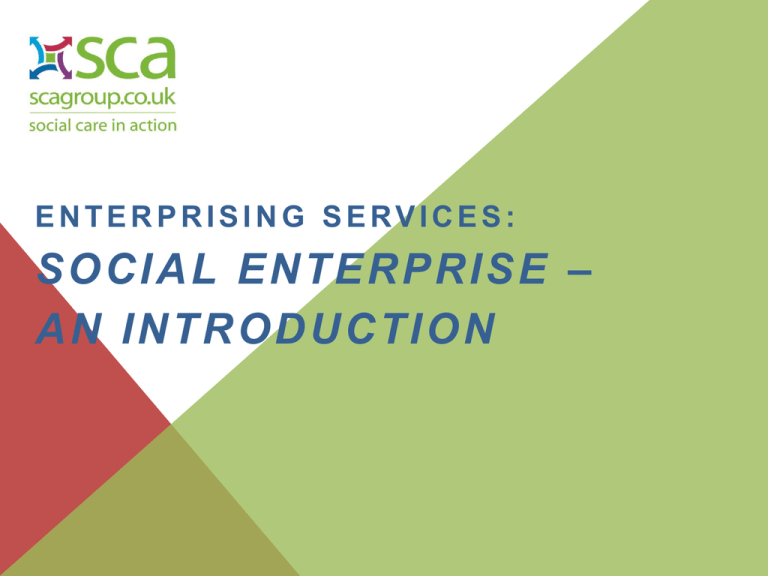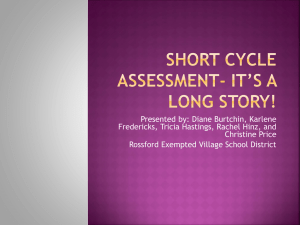SOCIAL ENTERPRISE IN ACTION
advertisement

ENTERPRISING SERVICES: SOCIAL ENTERPRISE – AN INTRODUCTI O N ABOUT SCA Formed 20 years ago – emerged from a CVS when started providing social care under contract to local authority Grew organically into care, health, transport and community services Now turnover £11.5 million, direct services to 100,000 people a year, coupled with wider community support. 600 staff and growing WHAT WE DO Care & Support – 20,000 people at home and in the community – specialisms include hospital discharge, reablement, high dependence, community based hubs Community Transport – 95,000 journeys a year – open up worlds and connecting people Wellbeing Centre – transformed disused community hospital to sustainable community owned enterprise Community Dentistry – 70,000 people a year access to NHS services Consultancy and training – delivered support to charities, local authorities and NHS Trusts SOCIAL ENTERPRISE A concept not an entity “A social enterprise is a business with primarily social objectives whose surpluses are principally reinvested for that purpose in the business or in the community, rather than being driven by the need to maximise profit for shareholders and owners” (Cabinet Office, UK Government, 2002) THE SOCIAL ECONOMY CHARACTERISTICS OF SOCIAL ENTERPRISES • Organisation with explicit social aim • Income predominantly derived from trading (at least in the long term): the sale of goods or services • Profit is for activities supporting social aim i.e. reinvestment, funding of social programmes, or profit-sharing • Alternative business model with multiple bottom lines ie. combines financial sustainability with social / environmental missions THE TRIPLE BOTTOM LINE BENEFITS OF SOCIAL ENTERPRISE • Flexible and innovative business model • Diversification and control of revenue sources offers potential for enhanced sustainability • Independent revenue offers ability for organisation to follow strategic vision rather than funding outcomes • Credible offer to take on public service provision • Appeals to public appetite for ethical trading • Services and activities that may not otherwise have been provided BUSINESS MODELS INCLUDE • Co-operative • Development Trust • Social Firm • Industrial and Provident Society • Credit Union and more… POPULAR AREAS OF SOCIAL ENTERPRISE SERVICE DELIVERY • health and social care – The SCA Group • transport services – SCA, HCT • refuse collection/recycling – Green-Works • sport and leisure services - GLL • housing and sheltered accommodation – Coin Street • early years childcare – London Early Years Foundation • disability support – Sector Mailing Services (Southampton) • retail – ONE/ Divine Chocolate 10 BENEFITS SOCIAL ENTERPRISE • Control •` Generate independent surplus • Ability to bid for greater number and range of contracts and business opportunities • Taking proactive response to budget cuts – protecting jobs and innovating in terms of delivery • Increased opportunity to involve service users in design and delivery • Opportunity to be part of fast growing, exciting business movement GROWING ENTHUSIASM… Increasingly government and larger charities keen to work with social enterprise in order to improve service delivery in a number of ways: • • • • • Income generation Community involvement Capacity to deliver beyond the public sector (bringing private finance into public service) Innovation in delivery Financial efficiencies CHALLENGES TO SOCIAL ENTERPRISE • Is there really a market? • Developing the culture of enterprise – who are the public sector social entrepreneurs? • Questions over how efficiencies are created – does it actually save money? • Using the market to deliver social impact • Impact on staff terms and conditions, including pensions • Lack of investment and finance CHALLENGES TO GROWTH - EXTERNAL • Commissioners lack of understanding of business model and mission • State Aid – many have received a great deal of public sector support • Scale – the drive to larger, fewer public contracts can hinder smaller providers, including social enterprises • The cost of winning public contracts – eg TUPE • Tighter financial margins give very little room for innovation • Private sector competitors increasingly skilled at promoting added social value – representing as effectively as social enterprises often do through the tender process • Perceived higher risk of social enterprise providers 14 CHALLENGES TO GROWTH - INTERNAL • Leadership inexperience – the skills and contacts to win public sector contracts are specialist and are not always present in social enterprise leadership • Corporate marketing and selling – scaling up is often a weakness • ‘Bankability’ – increasingly social investment funds are willing to support ‘unbankable’ enterprises, but public sector commissioners are not • Capacity – bidding takes a lot of work, and demands are only increasing • Willingness to create partnerships and bid as part of consortia • Demonstrating social value 15 ACHIEVING SUCCESS Aspiring social enterprise leaders and staff need to develop certain attributes and go through a clear process to establish a successful social enterprise: • • Need to show vision, energy, entrepreneurial spirit, business sense and focus Go through a seven step process: Outline vision Engage stakeholders Decide who’s in control Get the business plan in place Get the numbers right Negotiate with the local authority Get cracking! MORE INFORMATION The SCA Group www.scagroup.co.uk Social Enterprise UK www.socialenterprise.org.uk The Social Investment Business www.thesocialinvestmentbusiness.org UnLtd www.unltd.org.uk Social Firms UK www.socialfirmsuk.co.uk Co-operatives UK www.uk.coop Locality www.locality.org.uk Big Society Capital www.bigsocietycapital.com Community Action Hampshire www.actionhants.org.uk NCVO www.ncvo.org.uk Acevo www.acevo.org.uk 17 M AT T J A R R AT T DIRECTOR OF SOCIAL ENTERPRISE D E V E L O P M E N T, S C A G R O U P T: 0 2 3 8 0 5 1 6 0 1 5 E : M AT T. J A R R A T T @ S C A G R O U P. C O . U K











